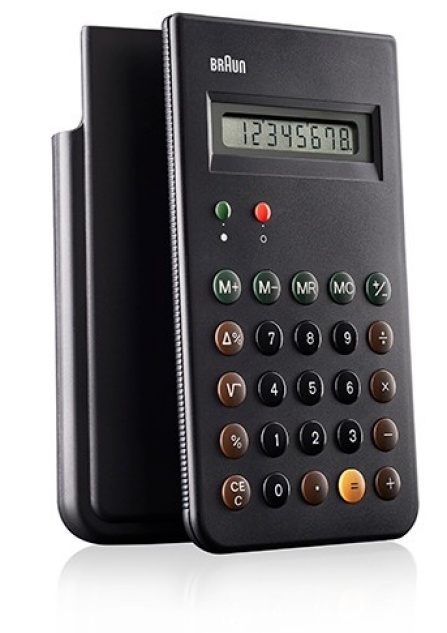Calculating change
BY MICHELLE KEARNS

The modern reissue of the 1987 Braun calculator was the model for the look of the iPhone calculator interface. In spite of the ubiquity of the digital phone version, customer demand led to the 21st century reproduction of the original Dietrich Lubs design, which was intended for everyday use. “The clarity and thus simple handling made it so popular until today,” wrote Thomas Guttandin of the Braun Archive in Germany. (Copyright BRAUN P&G/Braun Archive Kronberg)
The small, hand-held calculator was controversial when it was first mass produced cheaply enough for students to slip into a pocket, bring to school and make adults worry that young people would never learn how to add, subtract and multiply on their own.
But that’s not how the machines started out.
French mathematician Blaise Pascal got a patent in 1649 for his metal box with wheeled dials that could add and subtract. The evolution continued to 1958, just a year after the debut of Casio Computer Company’s desk-sized version, when a Texas Instruments engineer demonstrated a circuit on a small flat chip, said a post on the Hack Education blog by Audrey Watters, author of “Teaching Machines.”
That innovation led to the mass production of small, flat calculators. By the end of the 1970s, students were using them.
People fretted. “Well, there goes math. They’re going to turn it all over to calculators,” declared a department store manager who GSE Professor Emeritus Gerald Rising played golf with back then.
“Of course, that’s never happened,” said Rising, whose books include, “Inside Your Calculator: From Simple Programs to Significant Insights.”
As a retired math education professor and the co-founder of GSE’s Gifted Math Program, Rising thinks calculators help people swiftly tackle complex math, like loan amortization formulas.
“This allows students to focus on concepts rather than computations,” said Rising.
The latest calculation aid? The QR code. Rising’s new book, “About Mathematics,” features more than 100 phone-scannable squares that lead to pre-set calculation activities online. One on page 82 leads to an interface that reveals how a common 17.5 percent credit card rate takes $7 of a $10 payment for interest and only puts $3 toward principal.
Soon, Rising admits, calculators may be obsolete. “With the calculating apps on your phone,” he said, “you’re all set.”